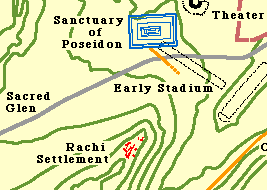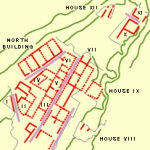The Rachi is a ridge running southwest to northeast, rising more than 50 meters above the Sanctuary of Poseidon and 103 meters above the nearby Saronic Gulf.
On the summit of this ridge located to the south of the sanctuary are the remains of a shrine to Demeter and Kore that was in use from the 6th to the 4th centuries B.C.. Although no structure associated with the shrine is preserved, votive deposits containing small vases (hydria, oinochoe) were discovered in and near several bedrock depressions during the 1954 excavations. In addition to the miniature vessels, evidence for the cult is provided by a variety of other votive objects such as terracotta reliefs, figurines, and metal objects.
A settlement was established on the Rachi in the last quarter of the 4th century B.C. after Corinth became the center of the Hellenic League under the control of Macedonia. At this time the Isthmian sanctuary also underwent a period of renovation which included a new stadium southeast of the Rachi. Small houses marked out in a pre-arranged grid and separated by narrow streets, provided homes to those who probably farmed the surrounding countryside and manufactured a variety of items for the Sanctuary of Poseidon and for visitors, including textiles and terracotta figurines. That honey and beeswax were produced is evident from the unique examples of ancient top-bar beehives found in the excavations. A deep well at the northwest corner of the settlement and a bottle-shaped cistern at the south provided water for the inhabitants.
What is most unusual about the site is that many buildings contain the remains of beam and lever presses for the production of olive oil, and, given the advantage of multi-purpose machines, may also have been used for wine. Basements in many of the houses were used to store amphoras. These installations are among the best preserved in Greece and direct evidence for the production of olive oil in the Corinthia during the Hellenistic period. Previous interpretation regarded the cement floors and tanks that form the presses as part of an ancient dye-works, but the 1989 excavations and study seasons of 1991-96 have brought forth convincing evidence to revise this view.
The destruction of the settlement during a campaign of the Second Macedonian War (198 B.C.) and its abandonment thereafter left the contents of the houses untouched until their discovery by the University of Chicago excavations in the 1954-56 and 1989 seasons. (pottery from the destruction layers)
For a complete report, see “The University of Chicago Excavations in the Rachi Settlement at Isthmia, 1989”, Hesperia Vol. 65 (1996), by Virginia Anderson-Stojanovic


